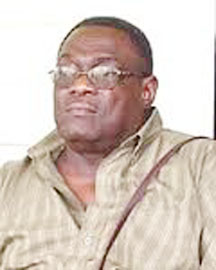By Iva Wharton
It is the prevailing view that women cricketers today are not treated as equals compared to their male counterparts. To begin with they earn far less than men, compete in fewer tournaments locally, regionally and internationally and to crown it all, there is less investment.
Claude Raphael, former co-ordinator of women’s cricket on the Guyana Cricket Board (GCB) and also representative on the West Indies Cricket Board (WICB) says that women’s cricket is grossly under developed.
Precious little, Raphael says, has been invested in promoting the sport, developing it and at the same time developing the players.

“Over the years we have taken women cricketers for granted (GCB), we have never exploited fully the skills we have within the women folk who are interested in participating in cricket as against those of the men,” the national selector said.
This, he said, is not only at the level of the GCB.
“As a matter of fact even at the West Indies Cricket Board level, there is some nonchalance in terms of how they view women’s cricket to the extent that the under-19 women’s cricket tournament has not been played for the last two to three years. It was just arbitrary struck off of the calendar of cricketing events.”
That, he said, discourages young women as they are no longer motivated because of the lack of tournaments for them to compete in.
Raphael is of the opinion that the GCB and WICB took up the responsibility of women’s cricket because it was mandated by the International Cricket Council (ICC) and also because they wanted to.
Using Essequibo as an example, Raphael said cricket stops in that county until the next inter-county tournament. There are no competitions as such, a team is assembled to represent the county at the inter-county level.
“That I think is the most serious part of the underdevelopment of women’s cricket. There has got to be tournaments organised during the year for them to participate and keep themselves up to the required standard,” he opined.
In Berbice, the girls are known for competing with their male counterparts in order to stay in shape and get the required practice necessary.
“I think if we can have cricket organised properly we can have a feeding system where they come from the schools, to the Under-19 and then go up to senior players.”
According to Raphael, tournaments similar to the male first and second divisions can be organised for women. This will allow them the opportunity to play more cricket within their counties and thus better prepared for the inter-county and regional tournaments.
Finance, he said has always been a problem, but there seems not be a difficulty in sourcing money for male competitions.
While a member of the GCB, Ramsey Ali had announced that he had secured sponsorship for women’s cricket, but that never materialized.
“I would also like to point to the fact that the last regional tournament that was played in Guyana resulted in a seven million dollars profit, some of which should have been ploughed back into women’s cricket,” he declared.
That he said was not done by the powers that be. He also said it was always difficult for the executive to get answers as what became of that money.
Raphael said the interest is just not there. According to him, while the WICB has a committee to handle women’s cricket it seems to be more of “a patronizing kind of lip service”.
Guyana has the chance to produce the best female team in the West Indies, but they have to be nurtured properly. “They have great talent, enthusiasm, exuberance, energy and interest”.
He said the momentum in women’s cricket has slowed down somewhat, because of the lack of tournaments. The hype he said was there two to three years ago.
The girls he said are not properly compensated when they make the national team. Some of these young women he said are in school, some are mothers while others have jobs aside of cricket. That was the reason for a few women leaving the sport.
A female on the national team he said, earns US$ 100 while her male counterpart makes US$ 700. This only represents payment for the one day tournaments.
The men also stand to earn more competing in the four day tournaments. There are not four day tournaments for women. That Raphael said is another area of concern as women should be given a chance, if not a four day tournament, then two days.
“It’s expensive to play cricket if you can’t get anywhere along the line and that is a concern for a number of women.”
He believes that a number of women are still interested in the sport, but the just need a leveled playing field and also the motivation.
Raphael said he does not believe that the presence of women in the GCB would yield different results. He said prior to the GCB assuming the responsibility for women’s cricket there was the Women’s Cricket Federation. It included the likes of Theresa Pemberton, Emily Dodson among other women who were advocates for women’s cricket. With the takeover, that federation fell under the purview of the GCB for which Raphael headed.
That committee Raphael said fell apart when the women left out of frustration. Many recommendations though accepted by the board were never implemented.
Raphael said he does not see women’s cricket changing anytime soon, because the interest is just not there. He said there needs to be a genuine interest.








